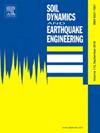Rate-dependent tensile behaviors of jointed rock masses considering geological conditions using a combined BPM-DFN model: Strength, fragmentation and failure modes
IF 4.2
2区 工程技术
Q1 ENGINEERING, GEOLOGICAL
引用次数: 0
Abstract
The dynamic tensile behavior of jointed rock masses is vital for geotechnical engineering but remains poorly understood due to the complex interaction between loading rates and joints. This study uses a combined BPM-DFN model to explore how joint intensity (0–20 m−1) and loading rates (10–40 MPa/ms) affect dynamic tensile strength, fragmentation, micro-crack evolution, and failure modes. Results show that tensile strength increases with loading rate but decreases with joint intensity. Fragmentation shifts from large fractures to complex breakage patterns as either factor rises. Micro-cracks evolve from tensile to shear with greater joint intensity, while higher loading rates promote tensile failure. A new model incorporating loading rate and geological strength index (GSI) is proposed. These findings enhance understanding of dynamic behavior in jointed rock masses, supporting better design and risk assessment in geotechnical projects.
考虑地质条件的节理岩体的速率相关拉伸行为:强度、破碎和破坏模式
节理岩体的动态拉伸特性对岩土工程至关重要,但由于加载速率和节理之间复杂的相互作用,人们对节理岩体的动态拉伸特性知之甚少。本研究采用BPM-DFN联合模型,探讨节理强度(0-20 m−1)和加载速率(10-40 MPa/ms)对动态抗拉强度、断裂、微裂纹演化和破坏模式的影响。结果表明:拉伸强度随加载速率增大而增大,随接头强度增大而减小;随着任何一个因素的增加,破碎从大型断裂转变为复杂的断裂模式。随着节理强度的增大,微裂纹由拉伸向剪切演化,而加载速率越高,拉伸破坏越严重。提出了一种结合荷载率和地质强度指数的新模型。这些发现增强了对节理岩体动力学行为的理解,为岩土工程的更好设计和风险评估提供了支持。
本文章由计算机程序翻译,如有差异,请以英文原文为准。
求助全文
约1分钟内获得全文
求助全文
来源期刊

Soil Dynamics and Earthquake Engineering
工程技术-地球科学综合
CiteScore
7.50
自引率
15.00%
发文量
446
审稿时长
8 months
期刊介绍:
The journal aims to encourage and enhance the role of mechanics and other disciplines as they relate to earthquake engineering by providing opportunities for the publication of the work of applied mathematicians, engineers and other applied scientists involved in solving problems closely related to the field of earthquake engineering and geotechnical earthquake engineering.
Emphasis is placed on new concepts and techniques, but case histories will also be published if they enhance the presentation and understanding of new technical concepts.
 求助内容:
求助内容: 应助结果提醒方式:
应助结果提醒方式:


